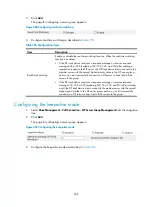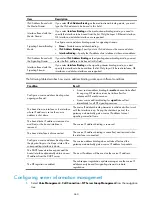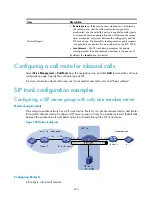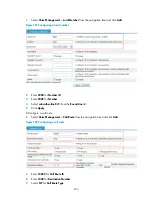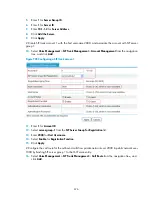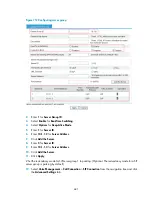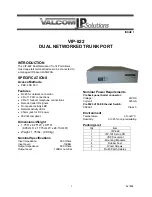
670
Item Description
Match a Source Host
Name Prefix
•
Specify the prefix of a source host name as a call match rule. The specified source
host name prefix is used to match against the source host names of calls. If the
INVITE message received by the SIP trunk device carries the Remote-Party-ID
header, the source host name is abstracted from this header field. If the INVITE
message received by the SIP trunk device carries the Privacy header, the source
host name is abstracted from the P-Asserted-Identity or P-Preferred-Identity header
field. If the INVITE message received by the SIP trunk device does not carry any of
the previously mentioned three header fields, the host name in the From header
field of the INVITE message is used as the source host name.
•
Specify the prefix of a source host name consists of 1 to 31 characters, which are
not case-sensitive and can include letters, digits, underlines (_), hyphens (-),
asterisk (*), and dots (.). An asterisk represents a character string of any length,
for example, t*m can match the source host names tom, tim, and so on.
Match a Destination
Host Name Prefix
•
Specify the prefix of a destination host name as a call match rule. The specified
destination host name prefix is used to match against the destination host names
of calls. The host name in the To header field of an INVITE message received by
the SIP trunk device is used as the destination host name.
•
Specify the prefix of a destination host name consists of 1 to 31 characters, which
are not case-sensitive and can include letters, digits, underlines (_), hyphens (-),
asterisk (*), and dots (.). An asterisk represents a character string of any length,
for example, b*y can match the destination host names boy, boundary, and so
on.
Match a Source
Address
IPv4
address.
Specify a source IP address as a call match rule. The value must be in
dotted notation and can include dots (.), multiplication signs (x), asterisks
(*), and digits, where
x
represents any number between 0 and 9,
*
represents any number between 0 and 255, and
x
and
*
can appear
multiple times in one source IP address. Fuzzy matching is supported. For
example, 100.1.x.3 indicates any IP address between 100.1.0.3 and
100.1.9.3, and 192.*.*.* indicates any IP address between 192.0.0.1
and 192.255.255.255.
DNS.
Specify a domain name as a call match rule. A domain name is not
case-insensitive and can include letters, digits, hyphens (-), underscores
(_), asterisk (*), and dots (.), with a maximum length of 255 characters.
If you provide this parameter, the specified domain name is used to
match against the source addresses of calls, and a whole-word match is
considered a match. For example, if the domain name is configured as
sohu, sohu.com is not a match. However, fuzzy matching is supported.
An asterisk represents a character string of any length, for example, i*n
can match the source addresses ilison, iverson, inn, and so on.
Server
Group.
Specify the index of a SIP server group as a call match rule.
Configuring coding parameters
The coding parameters of the call route of a SIP trunk account are the same as those of a call route. For
more information about coding parameters, see "Advanced settings."
Configuring other parameters
Other parameters of the call route of a SIP trunk account are the same as those of a call route. For more
information about other parameters, see "Advanced settings."
Содержание MSR SERIES
Страница 17: ...xv Documents 835 Websites 835 Conventions 836 Index 838 ...
Страница 20: ...3 Figure 3 Initial page of the Web interface ...
Страница 42: ...25 Figure 13 Firefox Web browser setting ...
Страница 59: ...42 Figure 27 Checking the basic service configuration ...
Страница 73: ...56 Figure 35 Sample interface statistics ...
Страница 156: ...139 Figure 139 Rebooting the 3G modem ...
Страница 168: ...151 Figure 152 Configuring Web server 2 ...
Страница 174: ...157 Figure 158 Configure the URL filtering function ...
Страница 187: ...170 Upon detecting the Land or Smurf attack on Ethernet 0 2 Router outputs an alarm log and drops the attack packet ...
Страница 242: ...225 Figure 233 Enabling the DHCP client on interface Ethernet 0 1 ...
Страница 247: ...230 Figure 236 The page for configuring an advanced IPv4 ACL ...
Страница 255: ...238 Figure 241 Advanced limit setting ...
Страница 298: ...281 e Click Apply 2 Configure Router B in the same way Router A is configured ...
Страница 354: ...337 Figure 339 Configuring a login control rule so Host B cannot access Router through the Web ...
Страница 400: ...383 Figure 387 Verifying the configuration ...
Страница 405: ...388 ...
Страница 523: ...506 Figure 530 Ping configuration page ...
Страница 538: ...521 a Click Device A on the topology diagram b Click Ethernet 0 2 on the panel diagram c Click Port Guard ...
Страница 744: ...727 Verifying the configuration In the case that the IP network is unavailable calls can be made over PSTN ...
Страница 775: ...758 Figure 785 Configuring a jump node ...
Страница 791: ...774 Figure 801 Configuring a jump node ...



